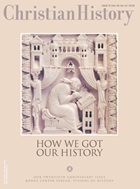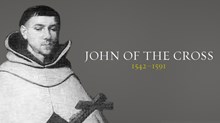Two perennial theological questions—"What must I do to be saved?" and "Where can I find the true church?"—took on special urgency in the Reformation era as the Christian world experienced an unprecedented crisis of authority. This crisis and its various resolutions all had roots in Renaissance learning.
As Copernicus and Galileo opened the heavens, and Columbus and Magellan mapped the world, humanist scholars such as Petrarch and Bruni encouraged a new interest in the study of history, especially the history of ancient Greece and Rome. The motto of all Renaissance scholars was ad fontes, "back to the sources," and the heart of this enterprise was the careful study of documents and texts. Sometimes these studies led to a radical critique of the institutional church and traditional theology (see "Church History's Biggest Hoax," page 35).
By the time of the Reformation, Desiderius Erasmus was applying the same kind of scholarly analysis to the Scriptures themselves. He produced a new edition of the Greek New Testament in 1516, and Luther used a copy in his famous attack on the practice of indulgences. Thus it was said that "Erasmus laid the egg that Luther hatched."
Luther would later part with Erasmus on crucial theological issues, but the textual and historical studies of humanist scholars enabled the Reformers to challenge many church practices and teachings in their efforts to restore "the true and ancient face" of biblical Christianity.
Reclaiming a hidden tradition
The role that history would play in subsequent Reformation debates was foreshadowed by Luther's 1519 confrontation with the Catholic theologian John Eck at Leipzig. Eck accused Luther of echoing Jan Hus, the Czech Reformer who had been burned at the stake at the Council of Constance in 1415. Luther was forced to admit that Hus had been right in some of his disputes with the church. Some of Luther's revolutionary ideas were not exactly new.
The principle of sola scriptura, Luther argued, also had a history—it had not been invented in the sixteenth century but had been taught by faithful witnesses through the ages. This position could not merely be asserted, however; it had to be argued and proved by historical analysis. The Reformation required a new Protestant historiography.
In his debate with Eck, Luther quoted Cicero's definition of history as "the mother of truth." This did not mean, of course, that history or tradition was the source of truth—only the revelation of God in Christ and the Bible could be that—but rather that history was the arena in which biblical claims could be understood and justified. In this sense, the Reformation was as much a battle for the Christian past as it was a struggle for the true interpretation of the Bible.
French Reformer John Calvin agreed. Calvin saw the world, including the realm of history, as "the theater of God's glory," and he urged Christian scholars to peruse the past in order to discover patterns of divine providence and spiritual blessing.
Calvin advocated a kind of historical scholarship that was both critical and providentialist, one in which the line between sacred and secular history was intentionally blurred. He wrote:
"It is not enough to have our eyes open and to note well and mark what God does during our lives, but we must profit from ancient histories. In fact, this is why our Lord has wanted us to have some notable judgments left in writing, so that the memory of them would remain forever. And we should not only profit from what is contained in Holy Scripture, but when we hear what is spoken by the histories written by the pagans, we should also have the prudence to apply to ourselves what God has done."
Rival visions
Johannes Sleidan (1506-1556) was one of the first historians of the Reformation epoch. Sleidan, a lawyer and diplomat trained in the disciplines of German humanism, lived through some of the seminal events of the sixteenth century: he was a secretary to a Catholic cardinal in France, a counselor to the Protestant city of Strasbourg, a correspondent of John Calvin, and an observer at the Council of Trent.
Sleidan was especially interested in the political shape of the Reformation, and his careful research resulted in a masterful survey of these events. His Commentaries on Religion and the State in the Reign of Emperor Charles V, published in 1555, became one of the most widely read narratives of the age.
Although personally committed to the Protestant cause, Sleidan tried to be impartial in retelling the saga of the Reformers and their opponents. His history of the Reformation had a lasting impact on the modern writing of history, but his perspective was skewed in several respects. By focusing so narrowly on Luther and Germany, he neglected other important centers of reform. Further, by concentrating so strongly on politics and statecraft, he gave an inadequate account of the religious vision and spiritual passion that framed so many of the events he described.
A far more ambitious, partisan, and comprehensive project was undertaken by the Lutheran theologian Matthias Flacius Illyricus and his colleagues in the city of Magdeburg. Historian Philip Schaff declared this 13-folio history of the church, known as the Magdeburg Centuries, "the first general church history deserving of the name."
Flacius and his co-workers scoured the libraries and archives of Europe, "from Scotland to Constantinople," collecting manuscripts and primary historical sources for their vast undertaking. The aim of the Centuries was clearly polemical: to show that the doctrines and practices of the Roman Catholic Church, including claims for papal supremacy, deviated from the path of the early church.
The Magdeburg Centuries rendered history a potent weapon in the arsenal of Protestant theologians. In response to the frequently asked question "Where was your church before Luther?" Protestant apologists could point to this impressive compilation of historical sources and argue that they, not their Catholic opponents, were the true church of biblical and patristic antiquity.
The Centuries remain a landmark in Reformation historiography. In the words of British historian A.G. Dickens, "They helped transfer the Reformation dispute to the historical forum." The very word "century" as we use it today derives from the structure of this work, which covered precisely 100 years in each of its 13 volumes.
On the negative side, the Centuries perpetuated Luther's language about the pope as Antichrist and also repeated certain myths about the Catholic past, such as the legend of Pope Joan. The pugnacious tone of the Centuries thus helped to harden the confessional divide between Protestants and Catholics on the eve of the Wars of Religion.
The Catholic church could not ignore the challenge of the Centuries. A work of similar magnitude and erudition was required to respond to the charge that the church of Rome had departed from its apostolic origins.
The church asked Caesar Baronius (1538-1607), an Italian cardinal and historian, to prepare a counter-history. Between 1588 and 1607, Baronius published 12 volumes of his Ecclesiastical Annals, a sweeping survey of the history of the church from its early days to 1193.
Like his Lutheran counterparts, Baronius collected many primary sources and documents to buttress his case. In addition to written materials, he also drew on archaeological evidence provided by the discovery of the catacombs in Rome in 1578.
The Annals offered major historiographical support for the Council of Trent. In various translations and abridged editions, this seminal work of the Counter Reformation influenced Roman Catholic interpretations of the Christian past well into modern times.
A gifted historian and researcher, Baronius brought to life many new facets of patristic and medieval church history. At the same time, his critical judgment sometimes "surrendered too easily to what he believed should have been true," especially where the ecclesiastical or temporal interests of the Church were concerned. For example, Baronius defended the authenticity of the Donation of Constantine, even though Lorenzo Valla had exposed it as a fraud more than a century earlier.
Writers from other traditions weighed in with less expansive, but still influential, histories of their own. Heinrich Bullinger, Ulrich Zwingli's successor at Zurich, wrote a popular history of the Swiss Reformation up to 1532. John Knox, the fiery Scottish Reformer, did the same thing for his native land in History of the Reformation of Religion within the Realm of Scotland (1587). Calvin's writings abound with historical references, too.
Dead men's (and women's) tales
The Reformation was an age of unprecedented religious violence and martyrdom. The writing of martyrologies became a major vehicle both for encouraging believers to remain faithful under pressure and for conveying to the next generation a compelling vision of Protestant identity and history.
In 1660 the Dutch Mennonite pastor Thieleman van Braght published Martyrs Mirror, a compilation of dramatic narratives and martyr stories from Anabaptists of an earlier generation. Refusing to swear oaths of allegiance or bear the sword, they embraced suffering and death as part of Christian devotion. By 1660 the persecution of Mennonites and other radical Reformers was largely over, but the Anabaptist vision of nonviolent discipleship continued to shape later generations through the reprinting and retelling of martyr stories.
The most influential of all the Reformation martyrologists was John Foxe (1517-1587). Along with the English Bible and the Book of Common Prayer, Foxe's Book of Martyrs decisively shaped English Protestantism.
While living in exile at Frankfurt and Basel during the reign of Mary Tudor, Foxe began to collect stories and documents about persecuted Protestants back in England, whom he called "the true professors of God's Gospel." Among the several hundred persons put to death during the Marian persecution, some were martyrs of rank and influence—Archbishop Thomas Cranmer, Bishops Hugh Latimer, Nicholas Ridley, and John Hooper, Reverend John Bradford—but others were martyrs of the rank and file, including women, children, and common laborers.
In 1563 Foxe's magnum opus—with the full title Acts and Monuments of These Latter and Perilous Days—appeared as a folio volume of 1,800 pages, including graphic woodcut illustrations. Foxe continued to revise and expand his book throughout his life. In 1583 he dedicated an updated version to Queen Elizabeth.
Perhaps because he had studied and seen the effects of persecution so closely, Foxe became an advocate for religious toleration and leniency. He appealed to Elizabeth to spare the lives of two Dutch Anabaptists accused of heresy, but to no avail.
What made Foxe's Book of Martyrs so appealing? First, he ably placed the recent events of the English Reformation in the context of the church's entire history. He claimed that the English had first been converted to Christianity not by Augustine of Canterbury, who was sent to England by Pope Gregory I in 596, but rather by Joseph of Arimathea, who supposedly visited England during the days of the apostles. Thus true English Christianity antedated the Roman mission to England and the corruptions that flowed from it.
Second, Foxe provided a convincing periodization of church history, dividing the centuries since the time of Christ into five distinct ages. In the first age, the apostles had guided the church as it was purified by persecutions from without. The second age involved the definition of true doctrine against various heresies and schisms. The third age witnessed the rise of the papacy and the suppression of the true gospel. The fourth age was introduced by John Wycliffe, "the morning star of the Reformation," and his Czech counterpart, Jan Hus, both of whom Foxe depicted as Reformation forerunners. The fifth and final age was that of the Reformation itself, the climactic epoch of church history that would end with the glorious return and reign of Christ on earth.
Third, Foxe was able to adapt this apocalyptic view of history to the age in which he lived. Whereas the Anabaptists marked the fall of the church with the rise of Constantine in the fourth century, Foxe depicted Queen Elizabeth as the new Constantine—the English Judith, Deborah, and Esther—called to establish the true Christian faith in God's "elect nation." One of Elizabeth's counselors went so far as to claim that "the Lord hath vowed himself to be English!"
Foxe died in 1587, but his vision of church history as the record of God's providential dealings with his people through cycles of decay and revival would long outlive him. Later Puritans and Separatists appealed to Foxe when it seemed to them that the official church had abandoned the principles of the Reformation. Foxe's Book of Martyrs was among the first volumes brought to America by the Pilgrims. "In those vast unpeopled countries of America," as Governor William Bradford referred to the Pilgrims' new homeland, Foxe and his book would help to shape the worldview of a new civilization.
Timothy George is dean of Beeson Divinity School of Samford University and executive editor of Christianity Today.
Copyright © 2001 by the author or Christianity Today/Christian History magazine.
Click here for reprint information on Christian History.

Support Our Work
Subscribe to CT for less than $4.25/month





























